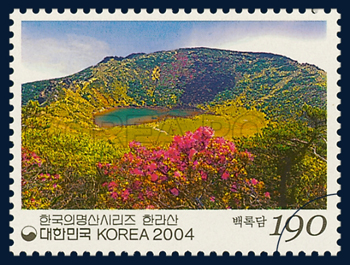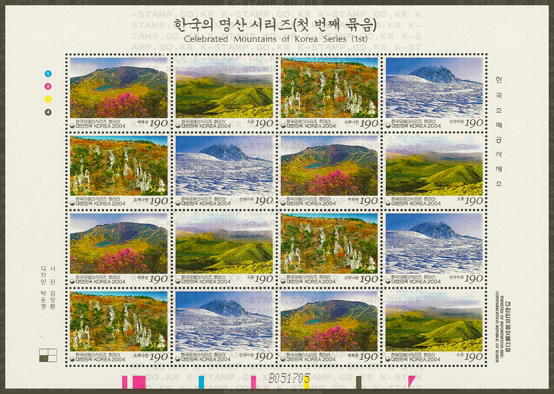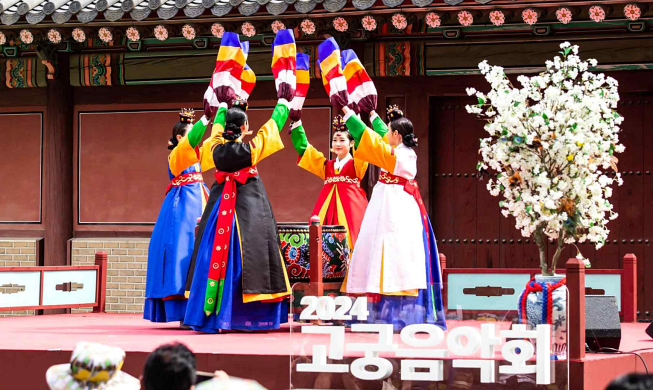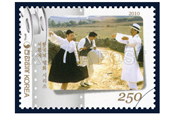-
 Korea.net's 24-hour YouTube channel
Korea.net's 24-hour YouTube channel- NEWS FOCUS
- ABOUT KOREA
- EVENTS
- RESOURCES
- GOVERNMENT
- ABOUT US

"Mountains are beautiful as they protrude from the earth," wrote poet Shin Seokjung.
Two thirds of the Korean Peninsula consists of mountains, and there are many famous mountains among them. The first bundle of "Celebrated Mountains of Korea Series" of stamps was issued by Korea Post in 2004. The first set includes Hallasan Mountain and describes the mysterious beauty of the Jeju Island mountain.

Hallasan Mountain extends from the center of the island, covering it from east to west. The southern slopes of the mountain are steep, while the northern side has a gentler slope.
The dormant volcano is mostly covered with basalt rock. The peak stands at 1,950 meters and it is the highest mountain in South Korea. The mountain extends 14.4 kilometers east to west, and 9.8 kilometers north to south. It covers some 103 square kilometers.
The Baengnokdam, the crater on top of Hallasan formed during its volcanic eruption, is 1,720 meters in circumference. The gigantic crater is 110 meters deep and always contains a lake of clear water in its basin.
The base of the mountain is registered as a natural monument and is protected by law. The mountain is a repository of alpine plants, too, with some 167 plants native to its slopes.
The eastern and western sides of the upper crater consist of different geographical features. The western side of the crater wall is made of trachyte formed during a volcanic eruption. There are walls of columnar joints with strange-looking rocky cliffs. The eastern side, on the other hand, consists of basalt that was discharged later during the mountain's lifespan.
Hallasan Mountain, including the Baengnokdam crater, has been included on UNESCO's list of World Heritage sites since 2007. Hikers can climb the mountain and reach the lake along two different courses: the Seongpanak route and the Gwaneumsa Temple route.

By Limb Jae-un
Korea.net Staff Writer
Photos: Korea Post
jun2@korea.kr
Two thirds of the Korean Peninsula consists of mountains, and there are many famous mountains among them. The first bundle of "Celebrated Mountains of Korea Series" of stamps was issued by Korea Post in 2004. The first set includes Hallasan Mountain and describes the mysterious beauty of the Jeju Island mountain.

The Baengnokdam stamp shows the beauty of the crater atop Hallasan Mountain. The stamp was issued in 2004.
Hallasan Mountain extends from the center of the island, covering it from east to west. The southern slopes of the mountain are steep, while the northern side has a gentler slope.
The dormant volcano is mostly covered with basalt rock. The peak stands at 1,950 meters and it is the highest mountain in South Korea. The mountain extends 14.4 kilometers east to west, and 9.8 kilometers north to south. It covers some 103 square kilometers.
The Baengnokdam, the crater on top of Hallasan formed during its volcanic eruption, is 1,720 meters in circumference. The gigantic crater is 110 meters deep and always contains a lake of clear water in its basin.
The base of the mountain is registered as a natural monument and is protected by law. The mountain is a repository of alpine plants, too, with some 167 plants native to its slopes.
The eastern and western sides of the upper crater consist of different geographical features. The western side of the crater wall is made of trachyte formed during a volcanic eruption. There are walls of columnar joints with strange-looking rocky cliffs. The eastern side, on the other hand, consists of basalt that was discharged later during the mountain's lifespan.
Hallasan Mountain, including the Baengnokdam crater, has been included on UNESCO's list of World Heritage sites since 2007. Hikers can climb the mountain and reach the lake along two different courses: the Seongpanak route and the Gwaneumsa Temple route.

The first set of 'Celebrated Mountains of Korea Series' shows the scenic spots of Hallasan Mountain.
By Limb Jae-un
Korea.net Staff Writer
Photos: Korea Post
jun2@korea.kr
Related Contents
Most popular
- Band Second Moon spreads fusion sound on California tour
- 76 national heritage sites to allow free admission from May 15
- First Korean-style 'taxi driver' diner opened in New York
- Africa's appeal on full display at downtown festival in Seoul
- UK univ., KCC in London host Korea Day event in Sheffield























